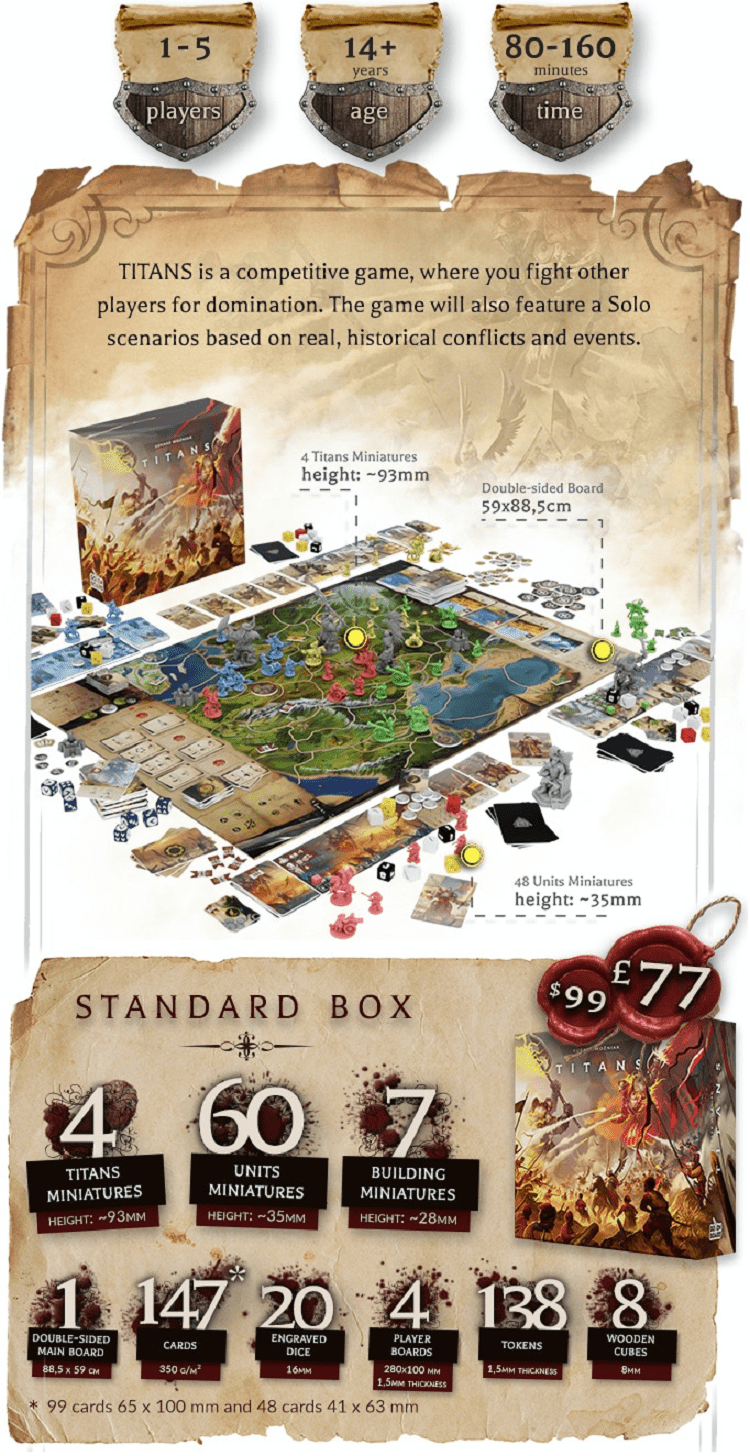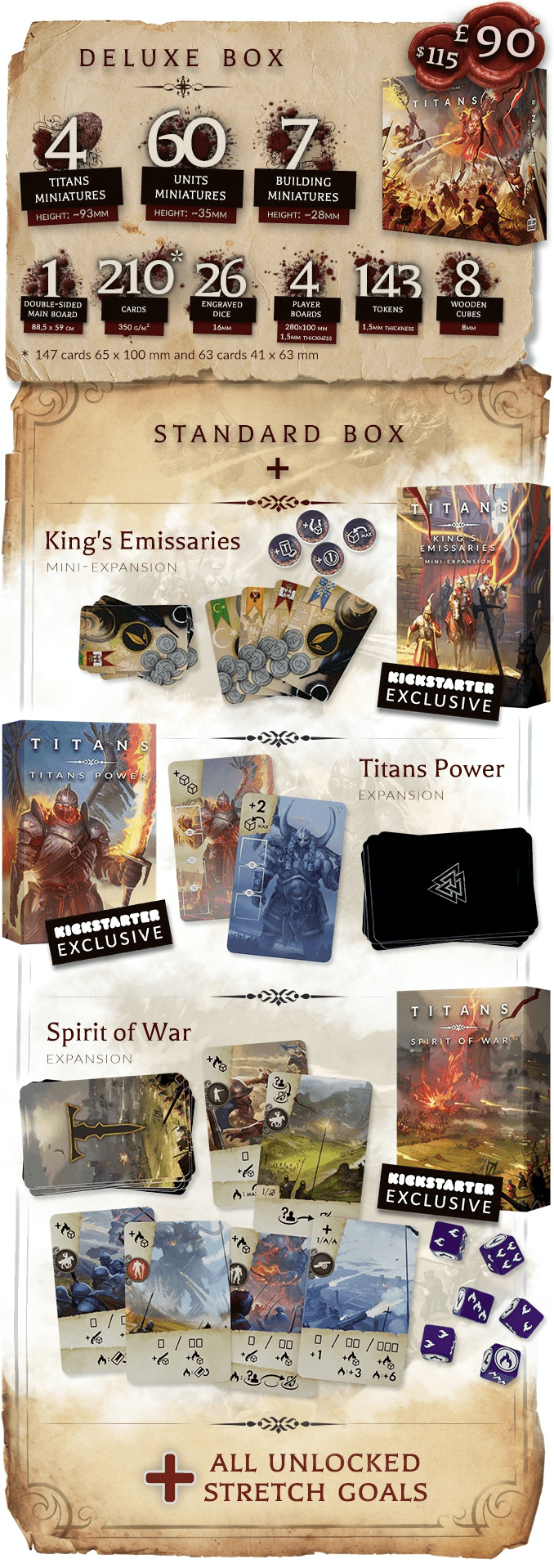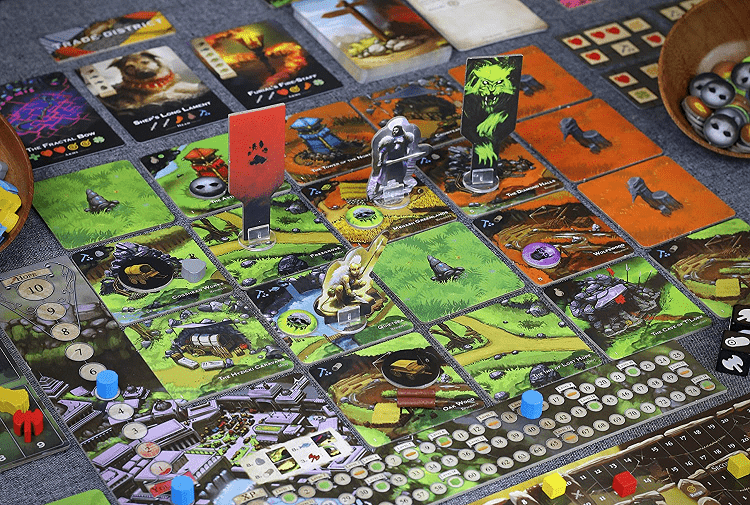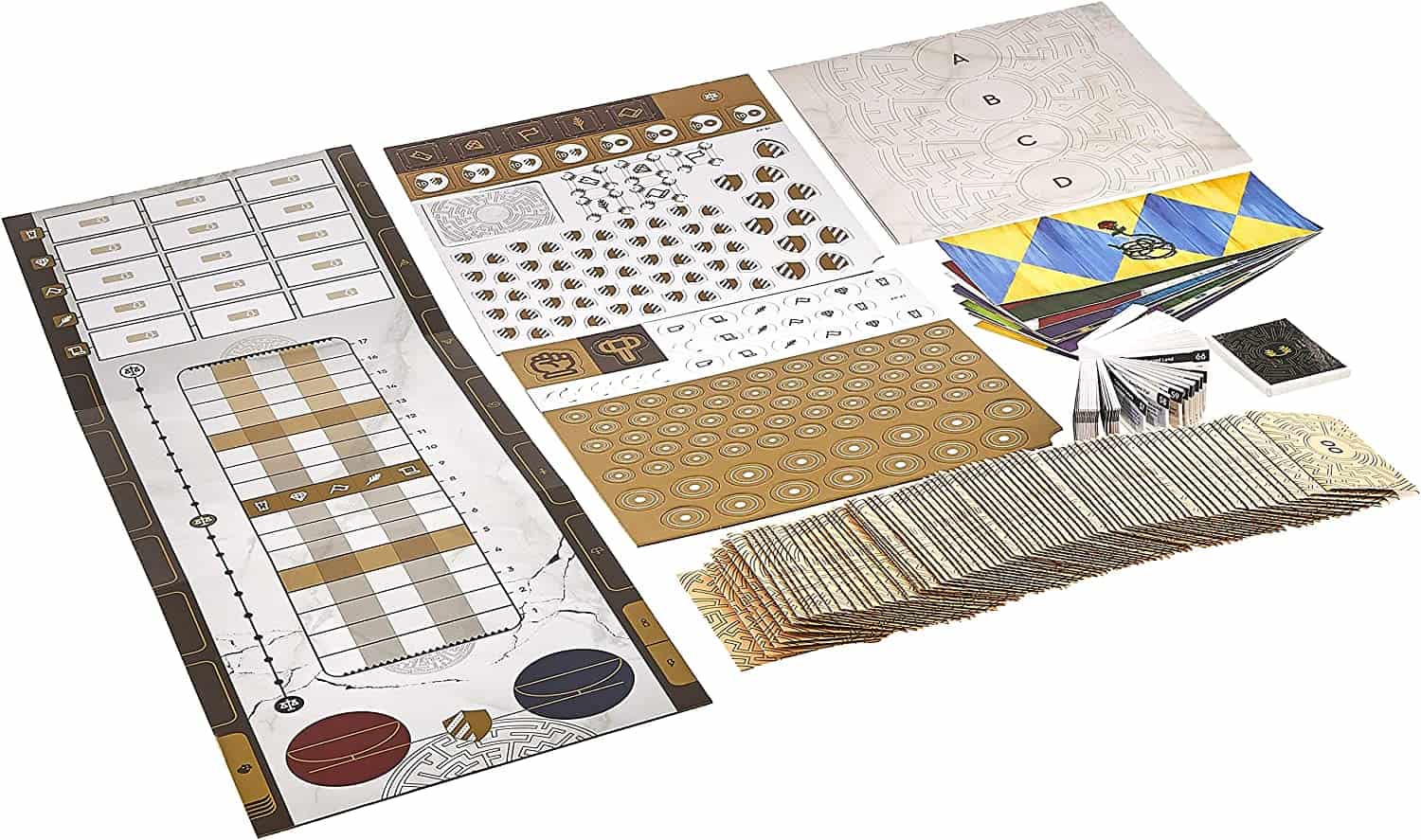In an alternate 17th century, people are falling into despair as endless brutal wars ravage Europe. The outlook is bleak, and almost all hope has vanished from hearts and minds. This is where Titans, a territory control game, takes place.
It sounds pretty bleak, doesn’t it? That’s what I love about Titans, though – the setting and backstory are so vivid that they make victory that much sweeter if you manage to achieve it.
As King, you have the power to change things. You can bring peace and security back to European nations. How? By leading an army into the war to end all wars, accompanied by a mythical Titan.
In this guide, I’ll explain why Titans is a fantasy game you won’t want to miss. First, let’s take a closer look at the game.
Titans: A Quick Overview
- Players: 1-4
- Recommended age: 13+
- Playing time: 80-160 minutes
Titans is a historical fantasy territory control board game released in 2021. It’s set in an alternative version of 17th century Europe where war has been raging for many years. Players take on the role of a powerful king who leads an army into battle to reclaim Europe and end all suffering.
The fate of Europe is in your hands. Think you can handle the pressure? Titans is a high-stakes game, that’s for sure, but you’ll have a little help from the mythical Titans.
Aim of the Game

The game is divided into just three rounds, so you need to make each one count. Victory points (VP) are awarded for each Region you own; to win, you need to have the highest score at the end of the final round.
While you can play Titans solo – which is worth doing – you can also play with your friends and compete for the title of “King of Kings.” I think a little competition makes the game much more exciting.
How to Play Titans Board Game
I’m still relatively new to Titans since it only came out in 2021, but I’ve already picked up some tips and tricks to help you on the path to victory. Keep reading to find out what they are.
Setup
First, you’ll need to spend a little time setting up the game (boring, I know, but unfortunately, it’s necessary).
Prepare the Board
Choose a scenario based on how many people you’re playing with and follow the setup process:
- Place the board on the table with the correct side facing up (A or B)
- Setup the Nations by positioning the Capitol and Units miniatures on the map
- Put the Nation boards with their corresponding cards, control tokens, remaining Units, and battle strength cubes on the side of the map
If any Regions are inactive, make them known with an inactive token. The round tracking token should be placed on the first spot, with the central Region token on the appropriate Region.
Ensure the victory points tokens and two sets of 8 battle dice are within reach of all players.
Pick the Nation to Lead

The game instructions suggest the youngest player should choose a Nation first, but you can decide this however you want. The first person to select a Nation gets the starting player token.
Don’t forget to collect your Nation board and other components when choosing your Nation.
Shuffle your Nation cards and put them face-down at the side of your Nation board.
Prepare the Order Deck
You need to take out the appropriate number of Order Cards for how many people are playing the game. In a four-player game, use all cards.
Shuffle the deck (make sure you do this correctly, especially if you’ve played the game before) and place it on its dedicated spot on the main board.
Prepare the Support Deck
This bit’s easy, so you can relax. Simply shuffle the support cards and put the deck face-down on its dedicated spot.
Each person then draws three cards at random.
Place four support cards, face-up, in the correct places near the deck.
Purchase Your First Nation Card
Every player draws three Nation cards from their deck, and you can see how much they cost in the top right corner.
Now you need to choose which one to buy – this is difficult when you’re as indecisive as me! When you’ve played the game a few times before, you’ll get a good feel for which Nations are best to choose.
Once everyone has chosen, the cards should be revealed all at once.
- Place your revealed card on the side of the Nation board
- Based on the cost, discard the required number of support cards
- You can also decide whether to put one of the remaining cards on the bottom of your Nation deck to potentially be used later
Draft Secret Objective Cards
Once again, you need to shuffle a set of cards, this time the secret objective ones. You’ll be an expert shuffler by the end of this!
Deal four cards to each player, who must then choose which one to keep. The remaining cards are passed to the player on your right, who chooses another card from the three.
This process is repeated until one card is left. The final card should be placed on the bottom of the deck.
You should now have three secret objective cards. Now you’re ready to get started and win this war!
Gameplay

As I mentioned earlier, the game is split into three rounds. The length of each round varies depending on when the order deck runs out.
Managing the Order Cards
When the first round begins, the starting player draws cards from the order deck equal to the order pool size for the number of players. These cards must be placed above the order pool, creating an upcoming order pool.
Taking a Turn
There are four phases in a turn:
- Order phase
- Resolving battles
- Draw one support card
- Clean up phase
Order Phase
This is the most essential part of your turn because it allows you to take actions. Simply select an order card and carry out the actions described on the card.
Actions include:
- Moving one Cavalry Unit to a neighboring Region
- Moving one Infantry Unit to a neighboring Region
- Moving one Artillery Unit to a neighboring Region
- Moving the Titan to a neighboring Region
- Moving one chosen Unit to a neighboring Region
- Moving between one and four Units from one Region to another
These are all pretty standard actions in a war game like this. But there are also some movement rules you should be aware of.
- Regions separated by a borderline are considered neighboring
- When your final Unit leaves a Region, place a control token in that Region to demonstrate your control
- You can’t take back control tokens from Regions with no Units
- The Capitol counts as a control token
- When you enter a Region with Enemy Units, this triggers a battle
- Keep attacking Units on the border between the exited Region and the one that’s under attack
The stronghold construction action is vital, so you should keep it in your mind.
My strategy is always to build as many strongholds as possible; doing so will improve your position and strength within the game. Here are the rules:
- Choose a Region you already control to build a stronghold
- Having units in a Region with a stronghold can alter certain aspects of the battle
- If a Region with a stronghold is otherwise empty, enemy Units can take the Region without a battle
That last rule makes things difficult for sure. My advice is to never take your eye off the ball – make sure the Regions you control are occupied by some Units and a stronghold.
Unit deployment actions can be used to enlist new Units from your reserve. Be careful when you decide to use this action, though, because once you run out of a specific type of Unit, you won’t be able to get any more.
Another action you can take is purchasing a Nation card. To do this, grab the top three cards from your deck and decide which ones – if any – you want to buy. The price is in the top right corner.
Resolving Battles
Following the order phase, a battle may have been initiated. Now is your time to shine by securing a glorious victory!
Try to familiarise yourself with the battle rules before you start playing because this will allow the game to run smoothly.
- Players are limited by the eight dice in one set
- The dice have a different number of “success symbols” indicating battle strength
- Only one Titan dice is rolled if the player has a Titan in battle
- The player with the higher strength wins
When the battle begins, each person takes all the dice matching their Units, then adds the strength value in their dice pool.
The defender takes the first battle stage, and the second is taken by the attacker. If the stronghold is attacked, the defender draws one support card.
If you’re defending your Region, you can take any of the following actions:
- Use Nation card(s)
- Discard support card(s)
- Play support card(s)
- Use the Titan special ability (once per battle)
- Use the Nation starting ability
The attacker may take the same actions as the defender during the attacker phase.
Having a stronghold in battle gives a defender two key advantages:
- The battle order is changed; it now begins with the attacker
- The defender draws a support card when a Region with a stronghold is under attack
If you manage to take control of an enemy Capitol region, you gain three VPs, so this should be your primary goal!
The battle’s outcome is determined by the strength difference between the two players involved. The losing player then has to destroy Units depending on this strength difference and remove Units from the Region.
Likewise, the winner is awarded a certain number of VPs based on this difference.
Drawing a Support Card

When you’ve resolved any battles in the previous phase, you draw a support card, either taking one of the four available or the top card from the support deck.
While drawing randomly from the deck might seem like a gamble, you don’t have to reveal your card to other players, which can work to your advantage. If the four support cards you can see don’t look particularly good, I’d suggest drawing from the deck instead.
Clean Up Phase
The final clean-up phase requires the active player to check two things: Titan development and support card hand limit.
When the active player has had the Titan destroyed, it should be placed on its side on the Nation board. If this is the case, it can now be raised to a standing position.
The active player also must make sure that they have no more than five support cards.
The turn is now complete; play continues clockwise.
End of the Round
When the final order card from the deck is all that remains, it should be discarded.
The round concludes when the active player’s turn is finished, and the clean-up phase starts. You can find the end of the round summary on the game board.
But wait… there’s something more. Each player now has the chance to reinforce.
What does that actually mean, I hear you ask?
Each person gets two reinforcements that offer different options.
First Reinforcement
Choose one of these options:
- Gain two support cards either from the top of the deck, the four existing cards, or one of each
- Draw two secret objective cards, putting one on the bottom of the deck and keeping the other
Second Reinforcement
Choose one of the following:
- Discard a support card and add any Unit to a controlled Region
- Purchase a Nation card
End of the Game
Now all that’s left to do is add up the scores and hold your breath. Will you have done enough to save the poor people of Europe from endless future wars? Add one victory point for each Region you control; the player with the most VPs is the winner.
If there is a tie, the player who controls the most Regions is the winner. If this number is the same again (unlikely, but not as uncommon as you might think), it’s the player with the most Units on the map.
How Many Pieces are there in Titans?

You’ll find the following components in the game box:
- 1x double-sided main board
- 22x inactive Region tokens
- 28x control tokens
- 3x stronghold miniatures
- 8x battle strength cubes
- 52x Units
- 1x round tracking token
- 1x starting player token
- 4x double-sided Nation boards
- 4x Capitol miniatures
- 1x central Region token
- 16x battle dice
- 40x Nation cards
- 24x secret objective cards
- 16x order cards
- 36x support cards
- 1x help card
- 2x rulebooks
- 12x automa cards
- Advanced mode components
- Victory point tokens
Alternatives to Titans
Here are some other games I think you’ll enjoy.
City of Kings

Like Titans, City of Kings features combat as a central part of its gameplay, so if you’re into war games, it’s worth giving this one a go. But the thing that makes it so enjoyable, at least for me, is that City of Kings has a deep, puzzle-like narrative that goes beyond battles and features stuff like worker management and quests.
You can find out more in our City of Kings guide.
- Players: 1-4
- Recommended age: 14+
- Playing time: 45-180 minutes
King’s Dilemma

This is my all-time favorite board game; if you decide to play King’s Dilemma, trust me, you’re in for a treat. It’s perfect if you enjoy games that unfold in stages or campaigns, with a little more narrative being revealed each time. The aim of the game is to influence the King to bring about favorable circumstances for the house you represent.
Our King’s Dilemma guide explains everything you need to know.
- Players: 3-5
- Playing time: 45-60 minutes
- Recommended age: 14+
Frequently Asked Questions
Question: Is Titans a Family Game?
Answer: Personally, I wouldn’t recommend it as a family game because it can be complex at times and may be challenging to learn how to play, especially for younger family members. Here are our recommendations for the best family board games.
Question: Can I Play Titans Solo?
Answer: Good news – you can! There are slightly different rules involved, so check the instructions booklet carefully. Alternatively, check out our guide to the best solo board games.
Question: How do I Know the Order Pool Size?
Answer: This is determined by the number of players.
• 2 players: order pool size 4
• 3 players: order pool size 5
• 4 players: order pool size 4
Question: How Often Can I Use Nation Cards in Battle?
Answer: Each card can be applied once per battle.
Question: What Support Cards are there?
Answer: There are the following support cards:
• Move one Unit into battle
• Add a die
•Add strength
Recommended reads:
- Stratego Pieces Explained – Must-Know Facts - February 28, 2023
- Wahoo Board Game Guide – AKA Aggravation Guide - February 22, 2023
- Pokemon Monopoly Guide - February 22, 2023

